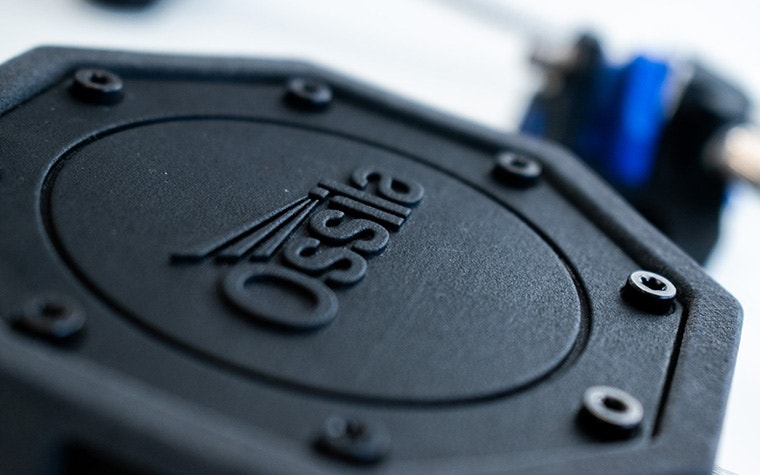CASE STUDY
Ossila Makes Assembly 5 Times Faster with 3D Printing

When Ossila chose 3D printing to produce their USB spectrometer, they struck a winning solution. Discover how it greatly reduced assembly time and made manufacturing easier, all while ensuring accuracy and light-tightness.
The challenge
Produce a small series of completely light-tight spectrometers
Ossila's USB spectrometer looks like any other: a small black box, commonly found in research labs around the country, with applications in everything from physics to biology. And just like any other, it shares the same requirements.
“One of the specifications we have is that the box needs to be really light-tight. It needs to be a really dense print, essentially,” explains Dr. David Coles, Research Scientist and Product Developer at Ossila. “The detector inside is so sensitive that even the tiniest amount of light — a few photons creeping their way through the lid or anywhere else — is just going to ruin the system completely.”
Traditionally, the method would be to cast or machine a box, then place and align each optical element within by hand. However, for a lean company like Ossila, this is as costly as it is time-consuming. The team wanted a different solution, so they turned to 3D printing at Materialise.
The solution
A small series run with 3D printing
“From a business point of view, cost is a strong motivator for choosing 3D printing, but that’s only part of the appeal,” says Dr. Coles. “It enables us to be more adventurous in our designs, to make them more complicated, making assembly much easier. We can do things that just wouldn’t be possible with traditional machining.”


Of course, the team at Ossila didn’t reach this stage overnight. The spectrometer went through several development phases, including an original model designed for two very different technologies.
“Our original designs were made in such a way that they could also be CNC machined, just in case the 3D printing didn’t work out. Luckily, the design rules for CNC are very similar to FDM, so we could print our prototypes in-house,” David tells us.
“But as soon as we got our first properly printed prototypes in, the whole direction changed — we just realized that it’s so much better, so much easier, so we dropped the millable requirement and focused completely on a 3D-printing-specific design.”


Part of this change in design was a shift from FDM to Multi Jet Fusion, with PA 12 seen as the ideal material. This particular combination offers the traditional design freedom associated with 3D printing, nanometer-accurate alignment, and the density Ossila demands to keep light from entering. Even the color — it’s naturally dark — helps minimize stray light from bouncing around inside the box.
And just as that combination was a perfect fit for the spectrometer, the convenience of working with Materialise was ideal for Ossila as a whole — lean manufacturing made easy.
“It makes life simpler for the manufacturing team. When we order, we generally need things in pretty quickly. Materialise hits the perfect balance between tight tolerances and fast lead times.”
“Today, we can build one of these systems in less than half an hour. That’s at least four or five times quicker than if we had to align every optical element individually.”
The results
The first commercially 3D-printed spectrometer on the market
The build itself is simple, consisting of only three parts: the main box, which holds all the optical elements; a second piece that bolts onto the bottom of the main box; and a lid to seal the deal. With traditional manufacturing techniques, this number would likely double — if not more.
“Each optical element would need its own holder, which we’d need to manufacture and align separately. So it’s not only the component count that’s come down, it’s also the ease of manufacturing. We don’t need complicated alignment jigs or special equipment. We can just drop the components into the design, and everything’s pre-aligned with the tolerances we need."
Understandably, this ease of assembly pays off in a big way.
“Today, we can build one of these systems in less than half an hour,” says Dr. Coles. “That’s at least four or five times quicker than if we had to align every optical element individually.”
Throughout the process, Materialise’s expertise and experience really shone through for Dr. Coles. The quality and consistency of the print have so far been impossible for others to match.
“We’ve tried other manufacturers over time, but it just seems like nobody can either get the tolerances right or match the density you provide. We continuously evaluate the process every time a new technology comes out, but we’ve not found anything that works anywhere near as well as what we get from Materialise. I don’t know what you’re doing, but it works for us!”
The future of 3D printing at Ossila
Knowing when and where to choose 3D printing is an important skill for any company, and it’s no different at Ossila. For Dr. Coles and his team, scale, price, and performance are the main drivers, but it’s safe to say that they're fond of all the technology has to offer.
“We’re finding that when we really dig into the requirements of our products, there’s not much we can’t 3D print. The technology is moving so fast that it’s only a matter of time before it’s the main manufacturing method for small-scale production.
“The quality is so good that it’s absolutely perfect for production. This means that the final prototype is the first release; there’s no more fine-tuning of tolerances or going through a second design process with a different specialist. We can just get straight on with it.”
Share on:
This case study in a few words
- Medtech
- Machinery and equipment
- PA 12
- Multi Jet Fusion
- Unmatched density to ensure a light-tight print
- High accuracy to ensure part alignment
- Fast lead times to enable lean manufacturing
